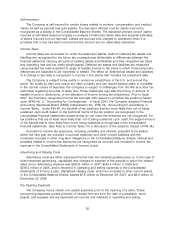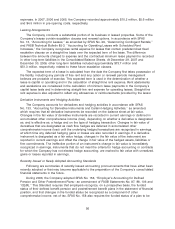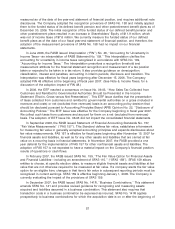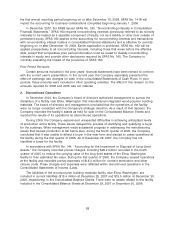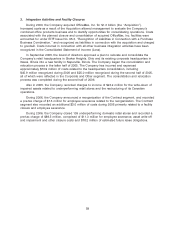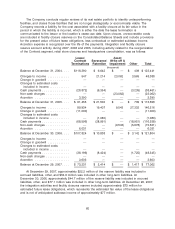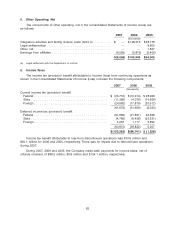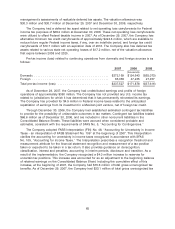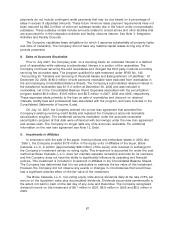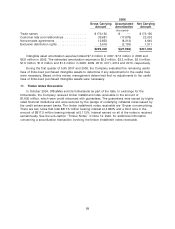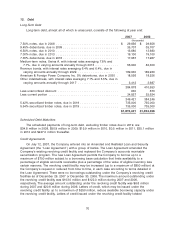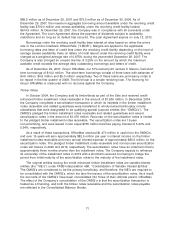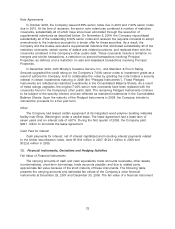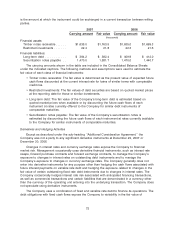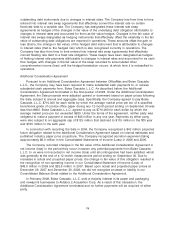OfficeMax 2007 Annual Report Download - page 68
Download and view the complete annual report
Please find page 68 of the 2007 OfficeMax annual report below. You can navigate through the pages in the report by either clicking on the pages listed below, or by using the keyword search tool below to find specific information within the annual report.
The tax effects of temporary differences that give rise to significant portions of the deferred tax
assets and deferred tax liabilities at year-end are presented below.
2007 2006
(thousands)
Current deferred tax assets (liabilities) attributable to
Accrued expenses ......................................... $ 38,096 $ 40,231
Net operating loss carryforwards ............................... 7,213 43,489
Allowances for receivables and rebates .......................... 29,605 17,998
Compensation and benefits .................................. 23,397 11,657
Inventory ................................................ 3,780 (6,047)
Property and equipment ..................................... 16,754 —
Alternative minimum tax and other credit carryforwards ............... 53,919 —
Other temporary differences .................................. 357 17,124
Contingency reserves ....................................... 11,949 5,044
Total current net deferred tax assets ........................... $ 185,070 $ 129,496
Noncurrent deferred tax assets (liabilities) attributable to
Deferred gain(a) ........................................... (473,838) (473,838)
Alternative minimum tax and other credit carryforwards ............... 188,033 214,590
Compensation and benefits .................................. 103,065 152,221
Net operating loss carryforwards ............................... 40,381 66,849
Reserves ................................................ 24,864 44,445
Investments .............................................. 6,399 10,046
Goodwill ................................................ (30,802) (33,110)
Other non-current liabilities ................................... 5,179 3,010
Undistributed earnings ...................................... (4,955) (4,776)
Deferred charges .......................................... 2,086 2,692
Property and equipment ..................................... 15,505 14,300
Other temporary differences .................................. 21 (4,430)
(124,062) (8,001)
Less: Valuation allowance .................................... (30,300) (30,734)
Total noncurrent net deferred tax assets (liabilities) ............... $(154,362) $ (38,735)
(a) Includes $543.8 million related to the gain on the sale of the Company’s timberlands to affiliates of Boise Cascade,
L.L.C. that was deferred until 2019 for tax purposes.
In assessing the realizability of deferred tax assets, management considers whether it is more
likely than not that some portion or all of the deferred tax assets will not be realized. The ultimate
realization of deferred tax assets is dependent upon the generation of future taxable income during
the periods in which those temporary differences become deductible. Management considers the
scheduled reversal of deferred tax liabilities, projected future taxable income, and tax planning
strategies in making this assessment. Management believes it is more likely than not that the
Company will realize the benefits of these deductible differences, except for certain state net
operating losses as noted below. The amount of the deferred tax assets considered realizable,
however, could be reduced if estimates of future taxable income during the carryforward period are
reduced.
The Company has established a valuation allowance related to net operating loss carryforwards
in jurisdictions where the Company has substantially reduced operations because management
believes it is more likely than not that these items will expire before the Company is able to realize
their benefits. Periodically, the valuation allowance is reviewed and adjusted based on
64



